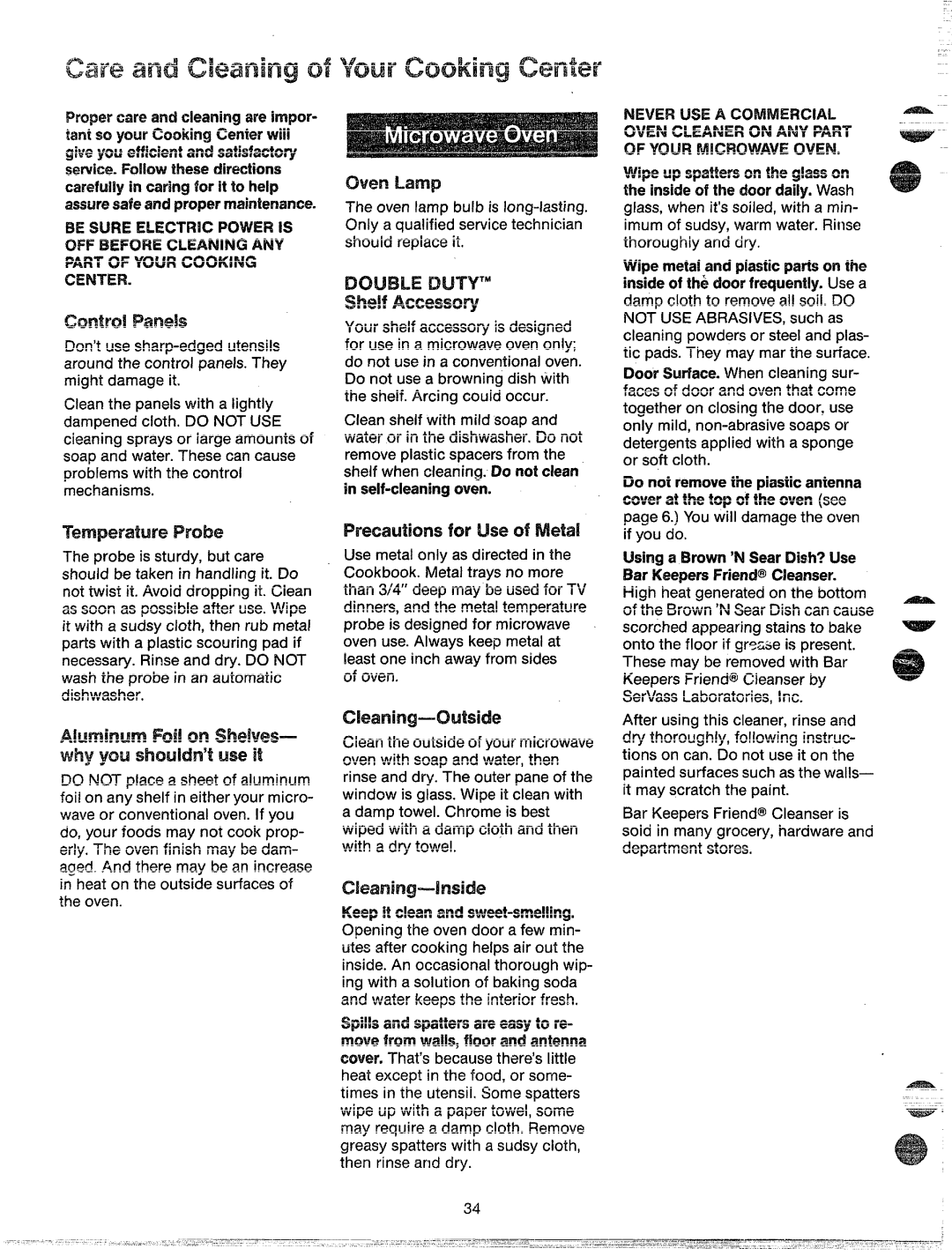
o
Proper awe and cleaning are irnfxw- tad so ytxlr Ch3khlg centerMM giveyou effkknt and satisfactory
service.RMow these directions carefuilyin earingfor it to help assuresafeand propermaintenance.
BE SURE ELECTRIC POWER Is
OFF 13EF0RECLEANING ANY PARTOF YOUR COOKING CENTER
R
Don’t use
Clean the panels with a lightly dampened cloth. DO NOT USE cleaning sprays or large amounts of soap and water. These can cause problems with the control mechanisms.
Probe
The probe is sturdy, but care should be taken in handling it. Do not twist it. Avoid dropping it. Clean as soon as possible after use. Wipe it with a sudsy cloth, then rub metal parts with a plastic scouring pad if necessary. Rinse and dry. DO NOT wash the probe in an automatic dishwasher.
| Foill on |
why you | l!!ilseit |
DO NOT place a sheet of aluminum foii on any shelf in either your micro- wave or conventional oven. If you do, your foods may not cook prop- erly. The oven finish may be dam-
The oven lamp bulb is
ENJn””
Your shelf accessory is designedW for use in a microwave oven only; do not use in a conventional oven. Do not use a browning dish with the shelf. Arcing could occur.
Clean shelf with mild soap and water or in the dishwasher. Do not remove plastic spacers from the shelf when cleaning. Do not clean in
for use of
Use metal only as directed in the Cookbook. Metal trays no more than 3/4” deep may be used for TV dinners, and the metal temperature probe is designed for microwave oven use. Always keep metal at least one inch away from sides
of oven.
Clean the outside of your microwave oven with soap and water, then rinse and dry. The outer pane of the window is glass. Wipe it clean with a damp towel. Chrome is best wiped with a damp cloth and then with a dry towel.
Keep it clean and
Spilisand spattersare easyto re- movefrom walls,floor and antenna cover, That’s because there’s little heat except in the food, or some- times in the utensil. Some spatters wipe up with a paper towel, some may require a damp cloth. Remove greasy spatters with a sudsy cloth, then rinse and dry.
NEVER USE A
OVEN CLEANER (X’+IANY PART
OF YOLIR | CM%!. |
Wipe up spatters on the glass on the insideof the door daily. Wash glass, when it’s soiled, with a min- imum of sudsy, warm water. Rinse thoroughly and dry.
Wipe meta!and plasticpartson the insideof th&doorfrequently.Use a damp cloth to remove all soil. DO NOT USE ABRASIVES, such as cleaning powders or steel and plas- tic pads. They may mar the surface.
Door Surface.When cleaning sur- faces of door and oven that come together on closing the door, use only mild,
Do not removethe plasticantenna coverat the top of the oven (see page 6.) Youwill damagethe oven if you do,
Using a Brown‘N Sear Dish?Use Bar KeepersFriend@Cleanser. High heat generated on the bottom of the Brown ‘N Sear Dish can cause scorched appearing stains to bake onto the floor if grezse is present. These may be removed with Bar Keepers Friend@Cleanser by SerVassLaboratories, Inc.
After using this cleaner, rinse and dry thoroughly, following instruc- tions on can. Do not use it on the painted surfaces such as the walls— it may scratch the paint.
Bar Keepers Friend@Cleanser is sold in many grocery, hardware and department stores.
V
34
